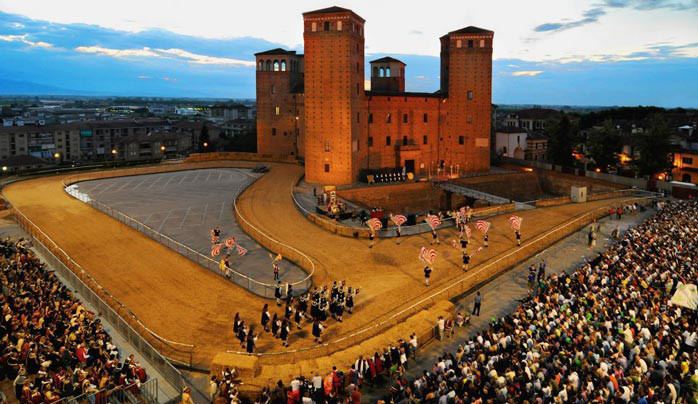Country Italy Demonym(s) Fossanesi | Elevation 375 m (1,230 ft) Local time Wednesday 10:42 AM Postal code 12045 | |
 | ||
Frazioni Boschetti, Cussanio, Gerbo, Loreto, Maddalene, Mellea, Murazzo, Piovani, San Lorenzo, San Martino, San Sebastiano, Santa Lucia, Sant'Antonio Baligio, San Vittore, Tagliata Weather 14°C, Wind N at 5 km/h, 56% Humidity | ||
Fossano is a town and comune of Piedmont, Italy, in the province of Cuneo. It is the fourth largest town of the Province of Cuneo, after Cuneo, Alba and Bra.
Contents
- Map of 12045 Fossano Province of Cuneo Italy
- History
- Etymology
- Old town
- Castle of the Princes of Acaja
- Other sights
- People
- Twin towns
- References
Map of 12045 Fossano, Province of Cuneo, Italy
It lies on the main railway line from Turin to Cuneo and to Savona, and has a branch line to Mondovì.
Chief industries of the town include confectionery (with Italian industries Balocco and Maina), chemicals, metallurgy, and textiles.
History
Fossano appeared as a commune in 1236, founded by a Guelph league of cities, but in 1251 had to yield to Asti. In 1304 it was acquired by the Marquisate of Saluzzo. It finally surrendered in 1314 to Filippo d'Acaia, whose successor handed it over to the house of Savoy.
Etymology
The name Fossano could be the transformation of the name "locus" or "fundus faucianus", from the Roman first name Faucius, or derive from the word "fossato" (ditch), in Piedmontese "fossà", from which "fossan" (inhabitant of the ditch).The sinkings are in fact characteristic of the hill on which the first city village rose. The historians agree speaking about “great ditch of the Chiotto”in dialect Ciot, hole, pit... Another alternative hypothesis is that the name comes from the latin “fons sana" (healthy spring), to indicate the presence in the proximitiy of a drinkable water spring.
Old town
The old section of Fossano lies in the high part of the town. It is divided in two borghi (ancient quarters): Borgo Piazza (Square's Quarter), developed in the 15th through 18th centuries, and Borgo Vecchio (Old Quarter), dating from the Middle Ages. Rich in mediaeval, Renaissance and Baroque buildings, it is characterized by the ancient portici (arcades), built on both sides of via Roma (the main street of the old town) but also along other streets, such as via Cavour, via Garibaldi, via Barotti, via Muratori. On the Eastern side, the old town is delimited by viale Mellano, a pedestrian promenade with views of Langhe; while on the Western side, along via Martiri dell'Indipendenza, viale Sacerdote and viale Bianco, there is a view of South-western Alps, whose apex is Monviso. Some sections of the ancient town walls are still extant.
Castle of the Princes of Acaja
The castle with four high towers, begun by Filippo d'Acaia in 1314 and finished in 1332. It has a square plan with four powerful towers at each side, connected by passages with merlons. One century later Amadeus VIII of Savoy turned it into a ducal residence; the beautiful inner courtyard, designed by Gaspare Solari, is from the late 15th century. After serving as jail and barracks, the castle is now the seat of cultural events and houses a regional library.
Other sights
The cathedral was reconstructed at the end of the 18th century in Neoclassical style, replacing the former 13th century church.
The town's hospital and the Trinity Church were designed by Francesco Gallo in the 18th century. The Palazzo del Comandante is a Baroque building constructed in the 17th century. There are also Mineral Baths and a center for agriculture and cattle-breeding.
